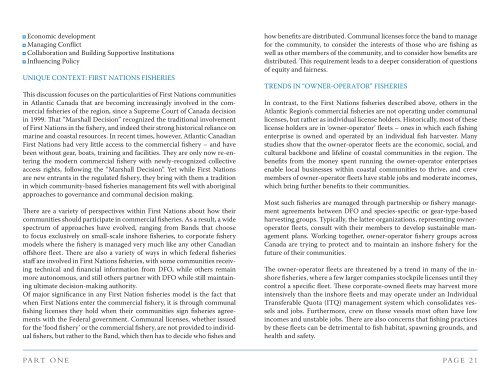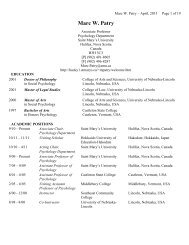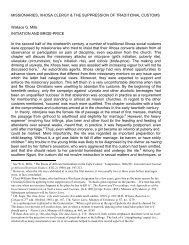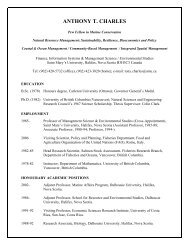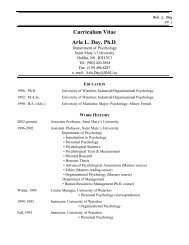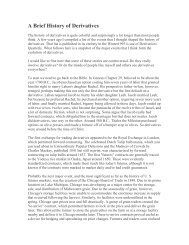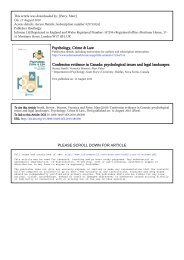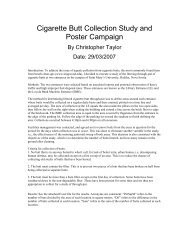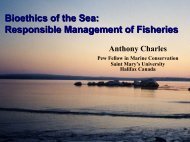Community Fisheries Management Handbook - Saint Mary's University
Community Fisheries Management Handbook - Saint Mary's University
Community Fisheries Management Handbook - Saint Mary's University
Create successful ePaper yourself
Turn your PDF publications into a flip-book with our unique Google optimized e-Paper software.
Economic development<br />
Managing Conflict<br />
Collaboration and Building Supportive Institutions<br />
Influencing Policy<br />
UNIQUE CONTEXT: FIRST NATIONS FISHERIES<br />
This discussion focuses on the particularities of First Nations communities<br />
in Atlantic Canada that are becoming increasingly involved in the commercial<br />
fisheries of the region, since a Supreme Court of Canada decision<br />
in 1999. That “Marshall Decision” recognized the traditional involvement<br />
of First Nations in the fishery, and indeed their strong historical reliance on<br />
marine and coastal resources. In recent times, however, Atlantic Canadian<br />
First Nations had very little access to the commercial fishery – and have<br />
been without gear, boats, training and facilities. They are only now re-entering<br />
the modern commercial fishery with newly-recognized collective<br />
access rights, following the “Marshall Decision”. Yet while First Nations<br />
are new entrants in the regulated fishery, they bring with them a tradition<br />
in which community-based fisheries management fits well with aboriginal<br />
approaches to governance and communal decision making.<br />
There are a variety of perspectives within First Nations about how their<br />
communities should participate in commercial fisheries. As a result, a wide<br />
spectrum of approaches have evolved, ranging from Bands that choose<br />
to focus exclusively on small-scale inshore fisheries, to corporate fishery<br />
models where the fishery is managed very much like any other Canadian<br />
offshore fleet. There are also a variety of ways in which federal fisheries<br />
staff are involved in First Nations fisheries, with some communities receiving<br />
technical and financial information from DFO, while others remain<br />
more autonomous, and still others partner with DFO while still maintaining<br />
ultimate decision-making authority.<br />
Of major significance in any First Nation fisheries model is the fact that<br />
when First Nations enter the commercial fishery, it is through communal<br />
fishing licenses they hold when their communities sign fisheries agreements<br />
with the Federal government. Communal licenses, whether issued<br />
for the ‘food fishery’ or the commercial fishery, are not provided to individual<br />
fishers, but rather to the Band, which then has to decide who fishes and<br />
how benefits are distributed. Communal licenses force the band to manage<br />
for the community, to consider the interests of those who are fishing as<br />
well as other members of the community, and to consider how benefits are<br />
distributed. This requirement leads to a deeper consideration of questions<br />
of equity and fairness.<br />
TRENDS IN “OWNER-OPERATOR” FISHERIES<br />
In contrast, to the First Nations fisheries described above, others in the<br />
Atlantic Region’s commercial fisheries are not operating under communal<br />
licenses, but rather as individual license holders. Historically, most of these<br />
license holders are in ‘owner-operator’ fleets – ones in which each fishing<br />
enterprise is owned and operated by an individual fish harvester. Many<br />
studies show that the owner-operator fleets are the economic, social, and<br />
cultural backbone and lifeline of coastal communities in the region. The<br />
benefits from the money spent running the owner-operator enterprises<br />
enable local businesses within coastal communities to thrive, and crew<br />
members of owner-operator fleets have stable jobs and moderate incomes,<br />
which bring further benefits to their communities.<br />
Most such fisheries are managed through partnership or fishery management<br />
agreements between DFO and species-specific or gear-type-based<br />
harvesting groups. Typically, the latter organizations, representing owneroperator<br />
fleets, consult with their members to develop sustainable management<br />
plans. Working together, owner-operator fishery groups across<br />
Canada are trying to protect and to maintain an inshore fishery for the<br />
future of their communities.<br />
The owner-operator fleets are threatened by a trend in many of the inshore<br />
fisheries, where a few larger companies stockpile licenses until they<br />
control a specific fleet. These corporate-owned fleets may harvest more<br />
intensively than the inshore fleets and may operate under an Individual<br />
Transferable Quota (ITQ) management system which consolidates vessels<br />
and jobs. Furthermore, crew on these vessels most often have low<br />
incomes and unstable jobs. There are also concerns that fishing practices<br />
by these fleets can be detrimental to fish habitat, spawning grounds, and<br />
health and safety.<br />
PA RT O N E<br />
PAG E 2 1


